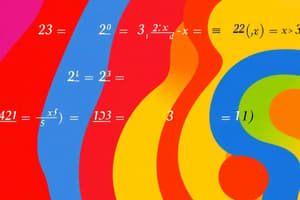Podcast
Questions and Answers
What is the main difference between the substitution method and the elimination method for solving systems of equations?
What is the main difference between the substitution method and the elimination method for solving systems of equations?
- The substitution method involves solving one equation for one variable, while the elimination method involves adding or subtracting equations to eliminate one variable. (correct)
- The substitution method is a graphical method, while the elimination method is an algebraic method.
- The substitution method is used for systems with two variables, while the elimination method is used for systems with three or more variables.
- The substitution method is used for linear equations, while the elimination method is used for nonlinear equations.
What is the primary purpose of the vertical line test in graphing functions?
What is the primary purpose of the vertical line test in graphing functions?
- To determine the range of the function.
- To determine if the relation is a function. (correct)
- To determine the domain of the function.
- To determine the x-intercepts of the function.
What is the formula for the sum of an arithmetic series?
What is the formula for the sum of an arithmetic series?
- S_n = (n/2)(a_1 + a_n) (correct)
- S_n = n(a_1 + a_n)
- S_n = a_1(1 - r^n) / (1 - r)
- S_n = a_1 + a_2 + ... + a_n
What is the quadratic formula used to solve?
What is the quadratic formula used to solve?
What is the primary characteristic of a geometric sequence?
What is the primary characteristic of a geometric sequence?
What is the purpose of graphing a quadratic equation?
What is the purpose of graphing a quadratic equation?
What is the definition of a function in terms of its domain and range?
What is the definition of a function in terms of its domain and range?
What is the method of solving systems of equations by graphing the related functions called?
What is the method of solving systems of equations by graphing the related functions called?
Flashcards are hidden until you start studying
Study Notes
Systems of Equations
- A system of equations is a set of two or more equations with two or more variables.
- Methods for solving systems of equations:
- Substitution method: solve one equation for one variable and substitute into the other equation.
- Elimination method: add or subtract equations to eliminate one variable, then solve for the remaining variable.
- Graphical method: graph the equations on a coordinate plane and find the point of intersection.
Functions and Graphs
- A function is a relation between a set of inputs (domain) and a set of possible outputs (range).
- Key features of graphs:
- Domain: all possible input values.
- Range: all possible output values.
- x-intercepts: points where the graph crosses the x-axis.
- y-intercepts: points where the graph crosses the y-axis.
- Asymptotes: lines that the graph approaches as x approaches positive or negative infinity.
- Graphing techniques:
- Vertical line test: if a vertical line intersects the graph at more than one point, the relation is not a function.
- Horizontal line test: if a horizontal line intersects the graph at more than one point, the function is not one-to-one.
Series and Sequences
- A sequence is an ordered list of numbers, denoted by {a_n}.
- A series is the sum of the terms of a sequence, denoted by ∑a_n.
- Types of sequences:
- Arithmetic sequence: each term is obtained by adding a fixed constant to the previous term.
- Geometric sequence: each term is obtained by multiplying the previous term by a fixed constant.
- Formulas:
- Arithmetic series: S_n = (n/2)(a_1 + a_n)
- Geometric series: S_n = a_1(1 - r^n) / (1 - r)
Quadratic Equations
- A quadratic equation is a polynomial equation of degree two, in the form ax^2 + bx + c = 0.
- Methods for solving quadratic equations:
- Factoring: express the equation as a product of two binomials.
- Quadratic formula: x = (-b ± √(b^2 - 4ac)) / 2a.
- Graphical method: graph the related function and find the x-intercepts.
- Key features of quadratic graphs:
- Vertex: the minimum or maximum point of the parabola.
- Axis of symmetry: the vertical line that passes through the vertex.
Polynomial Equations
- A polynomial equation is an equation consisting of variables and coefficients combined using only addition, subtraction, and multiplication.
- Degree of a polynomial: the highest power of the variable.
- Methods for solving polynomial equations:
- Factoring: express the equation as a product of simpler polynomials.
- Synthetic division: a shortcut for dividing a polynomial by a linear factor.
- Rational root theorem: potential rational roots of a polynomial equation are of the form ±(factor of constant term) / (factor of leading coefficient).
Systems of Equations
- A system of equations consists of two or more equations with two or more variables.
- Three methods for solving systems of equations:
- Substitution method: solve one equation for one variable and substitute into the other equation.
- Elimination method: add or subtract equations to eliminate one variable, then solve for the remaining variable.
- Graphical method: graph the equations on a coordinate plane and find the point of intersection.
Functions and Graphs
- A function is a relation between a set of inputs (domain) and a set of possible outputs (range).
- Key features of graphs:
- Domain: all possible input values.
- Range: all possible output values.
- X-intercepts: points where the graph crosses the x-axis.
- Y-intercepts: points where the graph crosses the y-axis.
- Asymptotes: lines that the graph approaches as x approaches positive or negative infinity.
- Graphing techniques:
- Vertical line test: if a vertical line intersects the graph at more than one point, the relation is not a function.
- Horizontal line test: if a horizontal line intersects the graph at more than one point, the function is not one-to-one.
Series and Sequences
- A sequence is an ordered list of numbers, denoted by {a_n}.
- A series is the sum of the terms of a sequence, denoted by ∑a_n.
- Types of sequences:
- Arithmetic sequence: each term is obtained by adding a fixed constant to the previous term.
- Geometric sequence: each term is obtained by multiplying the previous term by a fixed constant.
- Formulas:
- Arithmetic series: S_n = (n/2)(a_1 + a_n).
- Geometric series: S_n = a_1(1 - r^n) / (1 - r).
Quadratic Equations
- A quadratic equation is a polynomial equation of degree two, in the form ax^2 + bx + c = 0.
- Methods for solving quadratic equations:
- Factoring: express the equation as a product of two binomials.
- Quadratic formula: x = (-b ± √(b^2 - 4ac)) / 2a.
- Graphical method: graph the related function and find the x-intercepts.
- Key features of quadratic graphs:
- Vertex: the minimum or maximum point of the parabola.
- Axis of symmetry: the vertical line that passes through the vertex.
Polynomial Equations
- A polynomial equation is an equation consisting of variables and coefficients combined using only addition, subtraction, and multiplication.
- Degree of a polynomial: the highest power of the variable.
- Methods for solving polynomial equations:
- Factoring: express the equation as a product of simpler polynomials.
- Synthetic division: a shortcut for dividing a polynomial by a linear factor.
- Rational root theorem: potential rational roots of a polynomial equation are of the form ±(factor of constant term) / (factor of leading coefficient).
Studying That Suits You
Use AI to generate personalized quizzes and flashcards to suit your learning preferences.




